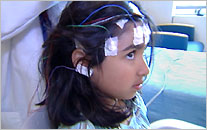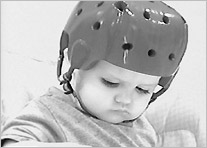Childhood Epilepsy: Seizure Types and Syndromes
Related Pages
Seizure Variability
A seizure is a sudden abnormal burst of electrical activity in the brain that causes an alteration of sensation, behavior, or consciousness. This general definition describes all types of epileptic seizures affecting children and adults. However, it says little about the wide variety of seizures that people experience, or why such variation exists.
Variation in seizure type is largely the result of where in the brain a seizure originates and how much of the brain it involves. For example, a seizure that originates on one side of the brain in the small region responsible for controlling hand muscles may cause twitching of the hand on the opposite side of the body. In contrast, a seizure that affects a very large region of the brain or the whole brain at once is likely to cause a widespread loss of motor control and consciousness. Given that seizure types also vary in their response to particular medical treatments, it is important to first identify seizure type before beginning a course of treatment.
To make sense of the vast constellation of seizure types, epilepsy experts have created a classification system that organizes the different types of seizures based on shared characteristics. Using this system makes it easier to understand the relationships and differences between them. This classification system is described below.
Seizure Classification: Partial and Generalized
"A seizure is like a hiccup, but different. A hiccup in my brain."
— Evan, 9 years old
Seizures are classified into two main categories: partial seizures and generalized seizures. Partial seizures are seizures that begin in one area, or focus, of the brain. They may or may not affect consciousness, depending on where in the brain they occur and the specialized brain structures they might involve. A partial seizure that does not affect consciousness is called a simple partial seizure. A partial seizure that alters consciousness is called a complex partial seizure. A seizure that begins focally, meaning in one area, and progresses to involve the entire brain is classified as a partial seizure with secondary generalization.

In contrast to partial seizures, generalized seizures appear to affect the entire brain spontaneously. Because of this, they inevitably alter consciousness. Specialists recognize two classes of generalized seizures based on how they manifest themselves. Nonconvulsive generalized seizures alter consciousness but do not cause convulsions; convulsive generalized seizures cause repetitive jerking and stiffening movements. Whether generalized seizures truly begin spontaneously or originate in one region of the brain but spread too quickly for current diagnostic technologies to detect a focus is unknown.
The broad categories of partial and generalized seizures contain many specific seizure subtypes. Some of the most common subtypes in each category are described below.
Types of Partial Seizures
Simple Partial Seizures
"I kind of start just looking at one place, and my arms tend to shake a lot, and I don't really move."
— Jeanny, 18 years old
The place of origin, or focus, of a simple partial seizure is often identifiable based on the seizure's manifestations. A seizure that begins in the region of the frontal lobe that is responsible for motor control may cause rhythmic movements of a finger, a hand, an arm, a leg, or the face. Seizures originating in the region of the parietal lobe responsible for sensory perception in the extremities may cause a burning or tingling sensation in the arms, hands, legs, or feet.
Simple partial seizures may also cause abdominal discomfort, an increase in heart rate or blood pressure, flushing of the face, feelings of fear, or sensations of déjà vu, depending on where they occur in the brain.
More about epilepsy & brain anatomyComplex Partial Seizure
Complex partial seizures may begin as simple partial seizures and then progress, or spread, to other areas of the brain, where they may affect consciousness or cause staring, confusion, or loss of alertness. In some cases, they also cause aimless movements, such as lip smacking or picking at clothes, the repetition of words or phrases, or inappropriate laughter.
Many complex partial seizures originate in the temporal lobe or frontal lobe. These two regions of the brain have many connections with each other and with central areas of the brain that control alertness and awareness. This explains, at least in part, why complex partial seizures have so many possible manifestations in addition to a characteristic loss of consciousness.
Given this diversity of manifestations, accurately identifying the focus of a complex partial seizure can be difficult and may require careful monitoring with an EEG or video EEG technologies. Without such careful assessment it may also be difficult to distinguish between a complex partial seizure and a type of generalized seizure called an absence seizure.
More about diagnosing epilepsyPartial Seizure with Secondary Generalization
Although most partial seizures remain localized in one area of the brain, any partial seizure may spread to involve the entire brain. Such events typically result in a convulsive tonic-clonic seizure. However, depending on the direction that the abnormal electrical activity spreads, they may result in an atonic seizure, in which a child loses all muscle tone and collapses, or a tonic seizure that causes sudden stiffening of the body, typically followed by a fall to the floor.
Often partial seizures with secondary generalization begin with an aura, a smell or other sensation that is unrelated to an individual's reality. Such sensations, if they normally precede recurrent generalized seizures, can serve as a warning that the larger seizure is forthcoming.
Distinguishing between this type of seizure and a generalized seizure can have significant treatment implications, given that particular medications may be most appropriate for one type and in some cases may actually make seizures worse if used for another type of seizure. It is also important to know that if partial seizures with secondary generalization prove difficult to treat with medications, they may be treatable with surgery. In contrast, surgery is not an option for generalized seizures.
Types of Generalized Seizures
Absence Seizures (pronounced ab-sonce)

Rose's absence seizures last a few seconds and involve eye fluttering and a blank stare.
"It impacted me socially because if I was talking to my friends I could have a seizure and then I could completely lose track of what I was saying."
— Rose, 14 years old
Most people with absence seizures experience what physicians call typical absence seizures, which may involve eye blinking, head bobbing, or jerky movements of the face or lips, in addition to the characteristic lapses of attention.
Myoclonic Seizures
Myoclonic seizures are generalized seizures characterized by single, intense muscular contractions that may result in a powerful jerk of the limbs, trunk, or head. They are thought to result from abnormal activity in an area of the brain responsible for muscle tone and posture. When myoclonic seizures cause the contraction of large muscle groups, such as the flexor or extensor muscles of the trunk, an individual may be thrown forward or backward powerfully, often sustaining injury.
Atonic Seizures

In contrast to myoclonic seizures, atonic seizures are sudden events that cause a complete loss of muscle tone or posture. All large muscle groups relax, the limbs go limp, and the individual falls to the floor or ground. Like myoclonic seizures, atonic seizures are thought to originate in areas of the brain that control muscle tone and posture. In fact, because the areas that cause muscles to relax are close to the areas that cause muscles to contract, children who experience atonic seizures may also experience myoclonic seizures, and vice versa.
Tonic Seizures
Tonic seizures are generalized seizures characterized by prolonged contraction of the large muscle groups involved in posture, as well as stiffening of the limbs. In contrast to many seizure types, tonic seizures do not produce rhythmic convulsions. They usually occur shortly before or after waking and usually involve most of the brain, typically resulting in a loss of consciousness.
Tonic-Clonic Seizures
Tonic-clonic seizures (formerly grand mal seizures) seizures) are the type most people imagine when they think about epilepsy, and they are a common type of seizure in children. These convulsive generalized seizures typically begin with a cry or sound caused by air being forced from the lungs, then progress to the tonic phase, which often involves a fall to the floor, stiffening of the limbs, clenching of teeth, and eyes rolling back. The tonic phase, which rarely lasts more than 30 seconds, is followed by the clonic phase, which presents itself as the rapid, rhythmic jerking of the limbs and torso. This phase is also characterized by shallow breathing, a bluish appearance to the skin, and loss of bladder and/or bowel control. The clonic phase typically lasts for a few minutes before it gradually begins to slow and eventually stops. After the seizure, individuals are typically difficult to rouse and, if awakened, will be sleepy and confused.
Mixed Seizures
It is not uncommon for someone who experiences one type of generalized seizure to occasionally have another type as well. For example, a child who periodically has myoclonic seizures may have a tonic-clonic seizure triggered by a mild fever. In fact, any generalized form of epilepsy, regardless of the type of seizure most often experienced, may give rise to tonic-clonic seizures in some circumstances.
Status Epilepticus
Although most seizures last anywhere from a few seconds to less than 5 minutes, occasionally a seizure will persist for 15 minutes or more, or an individual will experience back-to-back seizures without sufficient recovery time in between. This condition is called status epilepticus and should be considered a medical emergency, given that in some cases, if left untreated, it may cause long-lasting or permanent brain injury, or in rare cases, respiratory arrest and death. Although opinions vary with regard to the criterion for declaring status epilepticus, most experts now agree that an individual with a seizure lasting more than 10 to 15 minutes should be treated by a medical professional as soon as possible.
About epilepsy safety & first aidEpilepsy Syndromes
Childhood Absence Epilepsy (CAE)
Abnormal brain activity can result in a wide variety of seizure types, depending on where in the brain it occurs and how much of the brain is involved. In some people, patterns of recurrent seizures have also been observed. These patterns, considered distinctive forms of epilepsy, or syndromes, follow a similar course from one individual to the next, and often have characteristic EEG patterns. Importantly, individuals with a particular epilepsy syndrome also respond in a predictable manner to medications, and such syndromes may relate to underlying genetic factors and point to a family history of or predisposition to this form of epilepsy.
More about diagnosing epilepsy Maya's Story: Understanding the EEG
"We try to determine if the child's seizures fit into one of our epilepsy syndromes because that helps us educate the family and the child about what that means for the child's life and what the prognosis will be and may suggest treatment options."
— Elizabeth Thiele, MD, PhD
Epilepsy syndromes are sometimes grouped into two classes: benign and catastrophic. Seizures associated with benign syndromes are typically well controlled with medications and are often outgrown. In contrast, seizures associated with catastrophic syndromes often persist despite medication or the age of the child, and typically result in more extensive developmental problems. There are many epilepsy syndromes. A few of the more common types are described below.
Benign Epilepsy Syndromes
Childhood absence epilepsy (CAE) is an epilepsy syndrome characterized by absence seizures that occur from one to dozens, and sometimes hundreds of times per day. Seizures typically arise during childhood between the ages of four and eight years. Tonic-clonic seizures may precede absence seizures and may recur periodically after absence seizures have begun. Most children with childhood absence epilepsy outgrow the propensity for seizures by adolescence.
Benign Rolandic Epilepsy (BRE)
This syndrome typically arises after three years of age and is considered benign because children usually outgrow it by adolescence. In most children with benign rolandic epilepsy (BRE), seizures are infrequent and in some cases do not require medication. Characteristic manifestations of the syndrome begin with a sensation at the corner of the mouth and drooling, followed by jerking of the mouth that can progress to the rest of that side of the face, and sometimes to that entire side of the body. Although children remain conscious during this type of seizure, they are usually unable to speak for a period of time during and after the seizure. Seizures occur more commonly at night, especially during particular stages of sleep.
Juvenile Myoclonic Epilepsy (JME)
This syndrome typically begins in late childhood or early adolescence. It is characterized by mild myoclonic jerks as the individual is going to sleep or waking. Children describe intense feelings of jumpiness that generally subside after about 30 minutes. In addition to the myoclonic seizures, children with juvenile myoclonic epilepsy (JME) may also have periodic tonic-clonic seizures.
Catastrophic Epilepsy Syndromes
Infantile Spasms

"When Michael was about five and a half months of age we started to notice when he would wake up in the morning and after naps, he would drop his head, and kind of tilt it to one side, and his eyes would go off to the right side."
— Maureen, Michael's mother
Infantile spasms, a characteristic of West syndrome, are a form of myoclonic seizures that affects infants and very young children. They occur most often at 5 to 9 months of age, and are rarely seen in infants younger than 3 months or in children older than 18 months. These repetitive muscle contractions, usually involving the head, trunk, and extremities, typically occur in clusters, in which one spasm follows another after a brief period of time. A cluster may last 15 to 20 minutes and consist of many spasms. Clusters of infantile spasms typically occur as the child is going to sleep, or soon after waking.
Although not all spasms are immediately obvious, parents are still likely to pick up on the subtle cues that suggest something may be out of the ordinary with their child. Acting quickly on these suspicions by seeking the advice of a pediatrician or epilepsy specialist is critical to controlling infantile spasms. Appropriate treatment may in turn reduce the incidence and severity of learning disabilities and behavioral disorders associated with these seizures.
Doose Syndrome (also known as Myoclonic-Astatic Epilepsy or MAE)
Doose syndrome typically arises in children between the ages of one and five years. The seizures that result are generalized, and there is no known cause for this syndrome. In addition, seizures associated with Doose syndrome are often resistant to anticonvulsant medications, and other treatment options are often considered. Children with Doose syndrome typically experience mixed seizure types.
Michael had infantile spasms as a baby and is now doing well in school.
Michael's Story: Doose Syndrome and dietary therapyLennox-Gastaut Syndrome
This syndrome often arises between the ages of two and six years and is common among children who experienced infantile spasms. The syndrome has no single cause but typically results from some developmental brain disorder or brain injury. Children with Lennox-Gastaut syndrome have two or more seizure types, one of which is the atonic type of seizure, which causes loss of muscle tone and a sudden collapse to the ground. Lennox-Gastaut is considered a mixed seizure disorder and shows characteristic EEG patterns of slow spike and wave activity.
Treatment for the syndrome typically requires multiple medications, sometimes with little improvement. Because Lennox-Gastaut syndrome is difficult to treat and often comes with a poor prognosis, it is considered a catastrophic epilepsy syndrome. Fortunately, some children with Lennox-Gastaut respond well to medications and/or other anticonvulsant therapies, such as the ketogenic diet, and experience a great reduction or cessation of their seizures.
Landau-Kleffner Syndrome
This rare syndrome is characterized by a loss of speech due to abnormal electrical activity in the child's brain during sleep. Typically, an otherwise normally developing child experiences mild seizures and then slowly loses the ability to understand language, the ability to speak, as well as their interest in communicating. Individuals typically show near continuous epileptiform activity during as much as 80 percent of their sleep. The syndrome frequently causes lifelong language deficits. Unfortunately, a deeper understanding of the syndrome's cause and possible treatment remains elusive.
Conclusion
It is important to remember that these descriptions are for informational purposes only and should not be used as tools for self-diagnosis. Diagnosis of epilepsy and particular seizure types is a complex and difficult process involving sophisticated analyses by trained physicians. If you suspect that you or a family member has epilepsy, it is critical that you seek medical advice as soon as possible. Early diagnosis and treatment are the most important factors in a positive outcome for someone with epilepsy.
Support MassGeneral Hospital for Children
When you support MassGeneral Hospital for Children, you are making a significant impact to advancing patient care, research and education at the hospital.

